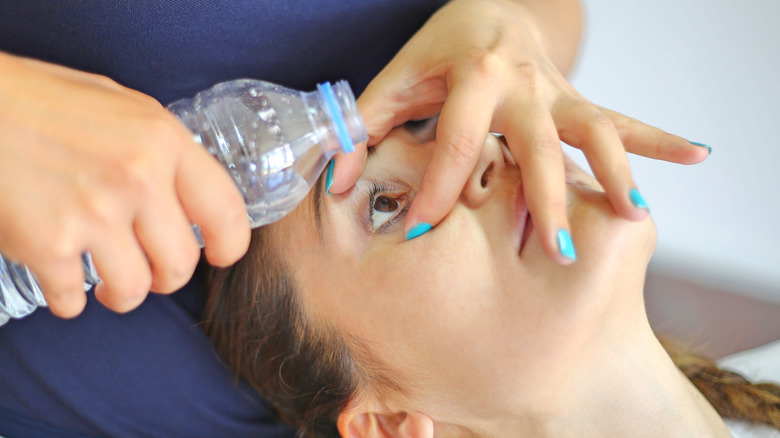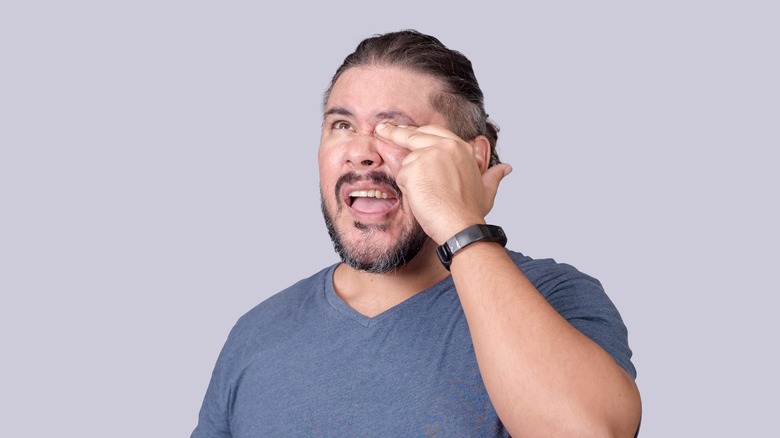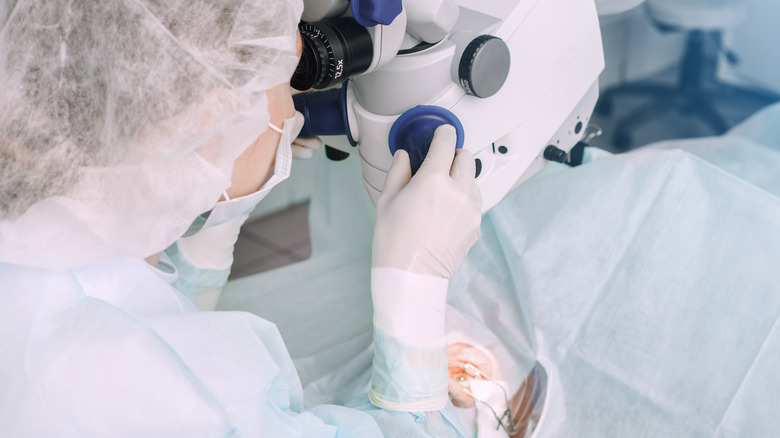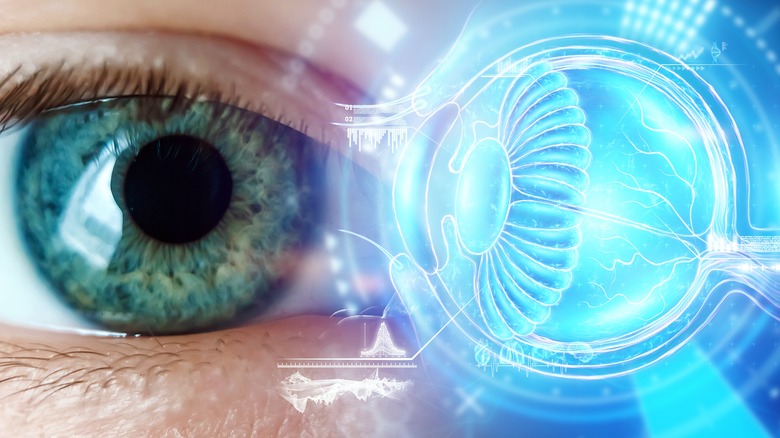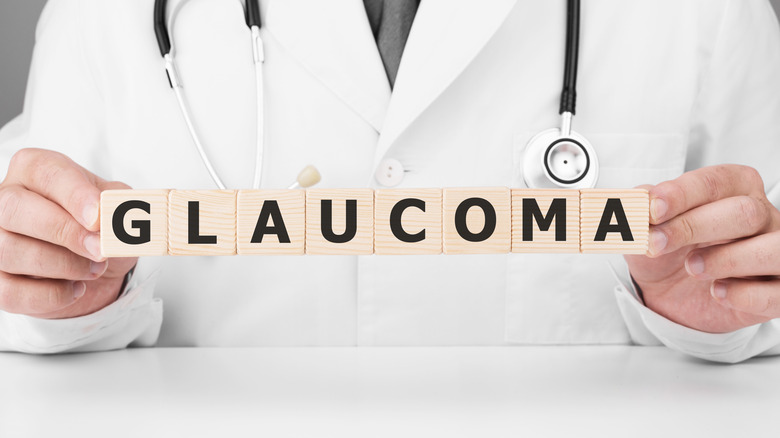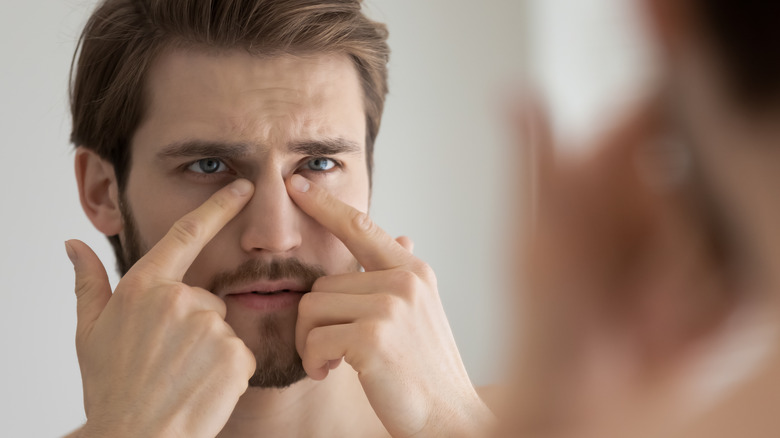Eye Concerns You Should Always Bring Up To Your Doctor
Most people will agree that vision is one of the most important senses bestowed upon humans, helping us enjoy the beauty of the world around us, maintain connections with family and friends, protect ourselves from danger, and keep our minds stimulated and sharp (via Marveloptics). With that in mind, caring for our eyes and vision should be a top priority, right?
Some eye problems are no big deal, and can be easily treated at home. Others require a visit to your doctor as soon as possible, or if home treatment doesn't clear up the problem. Still, others should have you rushing to the emergency department. Telling the difference can be tricky, so let's run through some guidelines for various conditions you may experience.
But first, some general tips for maintaining your eye health, straight from the Centers for Disease Control and Prevention: If you smoke, quit. Wear protective eyewear, whether you're lying on a beach or mowing your lawn. Maintain a healthy weight to minimize your chances of getting diabetes, a disease that can damage your eyes. And if you already have diabetes, keep your blood sugar levels under control.
Be aware of any eye-related health conditions that run in your family, and get regular, comprehensive eye exams to catch any eye diseases or conditions early. Some of the most serious eye problems don't have any noticeable symptoms until the diseases reach their later stages.
Chemicals in your eyes
It's a medical emergency if you get chemicals in your eyes, such as oven or drain cleaner, bleach, pesticide, or fertilizer, says Harvard Health Publishing. Your eyes can sustain damage within the first one to five minutes after contact, so the first step is to thoroughly flush your eyes with clean water. Next, get to the doctor, where a pH measurement of your eye's tears can determine if you were able to remove all of the toxin. The doctor also will probably check your vision with an eye test, and inspect your eyes for any damage. If damage is observed, you'll likely need to see an ophthalmologist for further testing.
While water is often the most readily available way to flush your eyes, WebMD recommends using a sterile isotonic saline solution if you have it on hand. Otherwise, consider stepping into the shower with all your clothes on, opening your eyes as wide as you can, and rinsing, rinsing, rinsing. Rinsing will probably continue once you're at the emergency department, and you may be given anesthetic eye drops that will numb the pain caused by washing.
If you've sustained a minor eye burn, antibiotic eye drops and oral pain medications may be all you need to recover at home. You may be admitted to the hospital if your burns are more substantial.
Foreign object stuck in eye
Ouch! You've got something stuck in your eye, and you probably want to get it out as quickly as possible. Sometimes, doing that yourself is a great idea, and shouldn't be too difficult. Other times, the DIY approach is a bad idea and you need prompt medical attention (via Mount Sinai).
The problem is most urgent if the foreign object could be a metal fragment. In that case, head to the emergency department right away, without attempting home treatment. Also, skip the DIY approach if your eyes are red, painful, sensitive to light, or have a discharge or a sore, or your vision is impaired. A regular doctor visit should be fine in these instances.
In other situations, home care should work fine. Wash your hands thoroughly before touching your eyes, and remove contact lenses if you wear them (via Medical News Today). Don't rub your eyes, and blink repeatedly to see if that can dislodge the object. If not, flush your eye thoroughly with water, saline solution, or artificial tears. Gently pulling your upper eyelid away from your eye may also help. Don't even think about using tweezers or other sharp objects around your eyes, and seek medical attention if you're still unable to remove the object.
A sudden increase in floaters in your eyes
As you and your eyes age, it's normal for the vitreous — the jelly-like substance that gives your eyes their shape — to start clumping and thickening (via the American Academy of Ophthalmology). As a result, you may start seeing dots, specks, or threads floating across your vision. If there are just a few occasional floaters, and they're not blocking your vision while you're driving or reading, they're not a serious problem and often just subside after a while. You're more prone to floaters if you've had cataract surgery or are nearsighted.
But don't breathe a sigh of relief quite yet. Floaters become a serious problem if you suddenly notice a big increase in the number of them (via Duke Health). Then it's time to get to the ophthalmologist right away, because you may have a tear in your retina that could progress to retinal detachment and vision loss. A sudden increase in floaters can also be a sign that your eyes are infected, inflamed, or bleeding, or that you have diabetes, all of which are reasons for a prompt doctor's visit.
While there's currently no known way to prevent floaters, getting a thorough eye exam every one or two years can help catch problems early, before they even become noticeable to you. More frequent exams may be recommended if you have diabetes or are nearsighted.
Flashes of light in your eyes
Flashes in your eyes might resemble sparkles, fireworks, or lightning, usually in the corners of your eyes (via The College of Optometrists). Flashes may be most noticeable when you're in a dark place, or when you're first waking up in the morning. They're usually less noticeable at other times during the day.
Like floaters, flashes most commonly occur in older people when the eyes' vitreous begins to shrink with age and starts tugging on your retina, says the Cleveland Clinic. Younger people may experience flashes as a symptom of a migraine, and treatment will probably focus on managing that condition. Retinal detachment or tears are the more serious cause because they can damage your eyesight, so get prompt medical attention if you suspect this is the problem, or if you notice an increase in the flashes.
Surgery is usually needed to repair detachments, tears, or holes in the retina, and there are a number of options, each with various risks and benefits (via the Mayo Clinic). Your doctor can explain the options and help you determine the approach that will best address the problem.
Lazy or wandering eyes in kids
Amblyopia is the medical term for lazy eye or wandering eye, conditions that typically affect children (via Children's Hospital of Philadelphia). Eyes that aren't aligned properly, cataracts, or the need for corrective glasses are a few of the causes. Children with Williams syndrome, Down syndrome, and Noonan syndrome also are prone to the condition.
With lazy eye or wandering eye, the brain is only receiving or responding to messages from one of the child's eyes. The other eye is going unused, and isn't developing normal vision. Symptoms include the child rubbing one eye, squinting, or needing to hold items unusually close to their face to see them. Children have the best chance of overcoming this problem if it's diagnosed and treated early, while their eyes are still developing, so seeing a doctor promptly is important.
Regular vision tests can catch amblyopia early, and treatment focuses on getting the child's brain to communicate with the weaker eye, get it in use, and train both eyes to work together. Treatment may include having the child wear an eye patch for several hours a day, utilizing eye drops to create blurred vision in the strong eye so the weaker eye learns to take control, or prescribing corrective glasses that help train the brain to use both eyes equally. If these approaches don't overcome the problem, surgery may be recommended to tighten the muscles of the eye. It's usually done on an outpatient basis.
Astigmatism
A normal eye is perfectly round; an eye with astigmatism isn't. Instead, it's oval or egg shaped, and that causes your vision to be blurry when looking at things up close or far away (via the American Academy of Ophthalmology). This common problem is often hereditary, but it also can be caused by eye disease or injury, or result from having eye surgery.
If you find yourself squinting or otherwise struggling to overcome blurred or distorted vision, or if you're bothered by headaches and eye strain, it's time to see your doctor for a complete eye exam. Often, astigmatism can be corrected with glasses or contact lenses, or LASIK surgery may be recommended to reshape the cornea.
Astigmatism is categorized as a refractive error, where structural abnormalities in your eye hinder clear visibility (via Medical News Today). Other refractive errors include farsightedness, nearsightedness, and presbyopia, an age-related condition where your ability to see things up close becomes compromised. An estimated 150 million adults and children in the United States have some form of a refractive error that needs to be corrected.
Glaucoma
Glaucoma is a condition that causes fluid to build up inside your eye. The fluid can put damaging pressure on the optic nerve, and ultimately result in vision loss (via the Glaucoma Research Foundation). Once you discover symptoms of the disease, you need to see a doctor right away, but the catch is that symptoms may not be noticeable in the early stages of the condition. That's why seeing a doctor for regular eye exams is so important. By taking baseline measurements of your eyes when you're around age 40, your doctor can track any changes over subsequent months and years, giving you the best chance of a timely diagnosis.
Changes to your peripheral vision may be the first noticeable sign of glaucoma, says the Mayo Clinic, and other symptoms can include blurred vision, severe headaches or eye pain, trouble with your central vision, and even nausea or vomiting. Infants and children can get glaucoma, and their symptoms may include cloudy eyes, excess tears when not crying, and increased blinking.
If symptoms come on out of the blue and are severe, you should go to the emergency department or your eye doctor's office immediately.
Cataracts
Picture the sky going from clear to cloudy, or your bathroom mirror fogging up while you're taking a shower. Those occurrences are similar to the way the lens of your eye gradually clouds up, usually over a few years, when you're developing cataracts (via Medical News Today). This common condition typically affects people who are 40 or older, but genetic factors may result in earlier onset, and some people are even born with the condition.
In addition to cloudy or blurry vision, you may experience a decline in your ability to see at night, as well as more sensitivity to glare. Distinguishing colors could become more difficult, or at least different, and you may find that you need to change the prescription on your eyewear more frequently.
Any of these symptoms should be a red flag to see your eye doctor, and the visit will probably include a discussion about any past eye problems, along with a variety of eye tests, says Prevent Blindness. If you do have cataracts, how much they're interfering with your daily life will determine whether it's time to consider surgery, or if another type of treatment is a better choice for you. While surgery can seem scary, you may find it comforting to know that more than two million people a year have cataract surgery in the United States, and the success rate is 95%.
Age-related macular degeneration
Seeing a doctor for regular eye exams is the best way to catch age-related macular degeneration (AMD), because the disease has no noticeable symptoms in its early stages. AMD is common among people 50 years of age and above, says Johns Hopkins Medicine, and symptoms that occur in the advanced stages may include an inability to read small type, recognize faces, or see clearly enough to drive. If you notice those symptoms, it's time to seek medical care right away.
Blurry or wavy areas in your central vision are other signs of AMD (via the National Eye Institute). The symptoms are caused by the macula, which controls the sharpness of your vision, becoming thinner as you age. The disease can cause serious loss to the center of vision, although it rarely results in total blindness.
Dry and wet AMD are the two types of the disease, and most people have the dry type. It typically has no symptoms until the late stages, when treatment isn't possible. Wet AMD is less common and progresses faster than dry AMD, but drugs that are injected into your eye, or a combination of injections and laser treatment, may help.
In addition to getting regular eye exams, your best chance of avoiding this condition is to cultivate a lifestyle that includes eating healthy foods, not smoking, and getting regular exercise.
Scratched eye
Even simple activities like playing with your cat or dog, trimming branches in the yard, or kicking up dirt on a walk can result in a scratched eye, with symptoms that include pain, a watery eye, and feeling like you've got something in your eye — besides your eye, that is.
If you've scratched the white part of your eye (called the sclera), you may notice redness, a spot of blood, or a visible scratch mark (via the American Academy of Ophthalmology). If the scratch is on your cornea, the clear dome over your iris and pupil, symptoms may be worse, including blurry vision, a headache, and sensitivity to light. Some cases of both types of these scratches will heal without medical attention, but the worse the injury, the faster you should seek help. In fact, if the pain is intense and your vision is impaired, you should head for the emergency department.
First aid for a scratched eye should start with rinsing your eye with clean water or saline solution, blinking repeatedly, and pulling your top eyelid down over your lower eyelid to help dislodge any debris that may have landed in your eye. Remove your contact lenses if you wear them and keep them out until the scratch is healed, and wear sunglasses if your eyes are sensitive to light. Don't use any over-the-counter eye drops until you consult an ophthalmologist; they might irritate your eyes and make matters worse.
Eyes burned by UV rays that cause persistent pain or vision changes
If you've ever burned your corneas by exposing your eyes to intense UV rays without adequate eye protection, it's probably an experience you don't want to repeat anytime soon. It feels like you've had sand thrown in your eyes and can result in redness, swelling, twitching eyelids, headaches, and temporary vision changes. And let's not forget that it's really painful (via the Cleveland Clinic).
The condition is called photokeratitis, and can occur while snow or water skiing, swimming, or lying on a beach with glare off the water or sand, to name just a few of the cornea-burning possibilities.
Self-care for photokeratitis includes going indoors right away, taking off any contact lenses you are wearing, and resting in a darkened room. A cold washcloth over your eyes can help ease the pain, along with over-the-counter tear drops and an anti-inflammatory drug like ibuprofen. Symptoms usually subside within six to 48 hours, but if pain or problems with your vision last longer than two days, seek medical attention. You may have an infection that requires antibiotic eye drops.
Sudden blindness
Now here's a scary one that — surprise, surprise — calls for emergency medical attention: You suddenly experience vision loss in one or both of your eyes over the course of a few seconds, minutes, or days (via JAMA Network).
Loss of your eyesight may be partial or complete, and possible causes include blood flow being blocked to or from the retina, inflammation of blood vessels in the eye or the optic nerve, or a symptom of a stroke. Depending on the cause of the problem, treatment ranges from eye drops to surgery, but the takeaway message here is that getting speedy help can minimize or reverse the damage.
In addition to being a possible symptom of a stroke that's already occurred, sudden blindness that is either partial or complete may warn of an impending stroke or heart attack, caused by a clot in a blood vessel in your eye, says WebMD. Without prompt medical attention, the clot could also result in permanent blindness. Your doctor may use medicine to break up the clot, or perform an angioplasty to clear out the blockage in the blood vessel.


